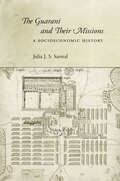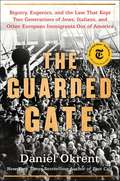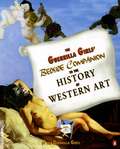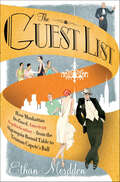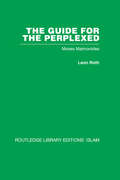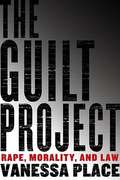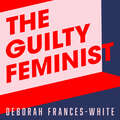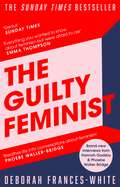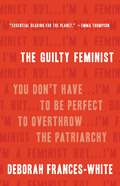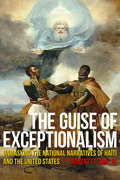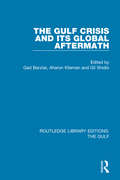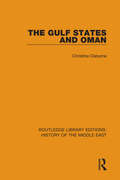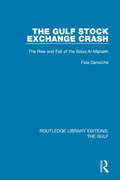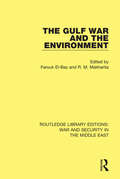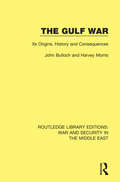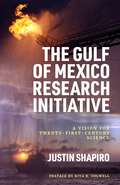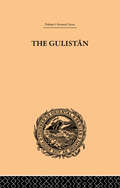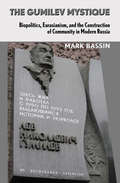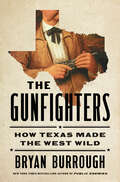- Table View
- List View
The Guaraní and Their Missions
by Julia J. S. SarrealThe thirty Guaraní missions of the Río de la Plata were the largest and most prosperous of all the Catholic missions established throughout the frontier regions of the Americas to convert, acculturate, and incorporate indigenous peoples and their lands into the Spanish and Portuguese empires. But between 1768 and 1800, the mission population fell by almost half and the economy became insolvent. This unique socioeconomic history provides a coherent and comprehensive explanation for the missions' operation and decline, providing readers with an understanding of the material changes experienced by the Guaraní in their day-to-day lives. Although the mission economy funded operations, sustained the population, and influenced daily routines, scholars have not focused on this important aspect of Guaraní history, primarily producing studies of religious and cultural change. This book employs mission account books, letters, and other archival materials to trace the Guaraní mission work regime and to examine how the Guaraní shaped the mission economy. These materials enable the author to poke holes in longheld beliefs about Jesuit mission management and offer original arguments regarding the Bourbon reforms that ultimately made the missions unsustainable.
The Guarded Gate: Bigotry, Eugenics and the Law That Kept Two Generations of Jews, Italians, and Other European Immigrants Out of America
by Daniel OkrentBy the widely celebrated New York Times bestselling author of Last Call—the powerful, definitive, and timely account of how the rise of eugenics helped America close the immigration door to “inferiors” in the 1920s.A forgotten, dark chapter of American history with implications for the current day, The Guarded Gate tells the story of the scientists who argued that certain nationalities were inherently inferior, providing the intellectual justification for the harshest immigration law in American history. Brandished by the upper class Bostonians and New Yorkers—many of them progressives—who led the anti-immigration movement, the eugenic arguments helped keep hundreds of thousands of Jews, Italians, and other unwanted groups out of the US for more than 40 years. Over five years in the writing, The Guarded Gate tells the complete story from its beginning in 1895, when Henry Cabot Lodge and other Boston Brahmins launched their anti-immigrant campaign. In 1921, Vice President Calvin Coolidge declared that “biological laws” had proven the inferiority of southern and eastern Europeans; the restrictive law was enacted three years later. In his characteristic style, both lively and authoritative, Okrent brings to life the rich cast of characters from this time, including Lodge’s closest friend, Theodore Roosevelt; Charles Darwin’s first cousin, Francis Galton, the idiosyncratic polymath who gave life to eugenics; the fabulously wealthy and profoundly bigoted Madison Grant, founder of the Bronx Zoo, and his best friend, H. Fairfield Osborn, director of the American Museum of Natural History; Margaret Sanger, who saw eugenics as a sensible adjunct to her birth control campaign; and Maxwell Perkins, the celebrated editor of Hemingway and Fitzgerald. A work of history relevant for today, The Guarded Gate is an important, insightful tale that painstakingly connects the American eugenicists to the rise of Nazism, and shows how their beliefs found fertile soil in the minds of citizens and leaders both here and abroad.
The Guerrilla Girls' Bedside Companion to the History of Western Art
by Guerrilla GirlsTaking you back through the ages, The Guerrilla Girls demonstrate how males have dominated the art scene and discouraged or obscured women's involvement. Their sceptical and hilarious interpretaions are augmented by other feminists.
The Guest List: How Manhattan Defined American Sophistication—from the Algonquin Round Table to Truman Capote's Ball
by Ethan MorddenFrom the 1920s to the early 1960s, Manhattan was America's beacon of sophistication. From the theatres of Broadway to the lobby of the Algonquin Hotel to tables at the Stork Club, intelligence and wit were the twinned coins of the realm. Alexander Woolcott, Irving Berlin, Edna Ferber, Arturo Toscanini, Leonard Bernstein, Cole Porter, Dorothy Parker, Truman Capote, the Lunts and Helen Hayes presided over the town. Their books, plays, performances, speeches, dinner parties, masked balls, loves, hates, likes and dislikes became the aspirations of a nation. If you wanted to be sophisticated, you played by Manhattan's rules. If you didn't, you simply weren't on the guest list. The Heartland rebelled against Manhattan's dictum, but never prevailed. In this lively cultural history, Mordden chronicles the city's most powerful and influential era.
The Guide for White Women Who Teach Black Boys
by Marguerite W. Penick-Parks Eddie Moore Jr. Ali MichaelSchools that routinely fail Black boys are not extraordinary. In fact, they are all-too ordinary. If we are to succeed in positively shifting outcomes for Black boys and young men, we must first change the way school is “done.” That’s where the eight in ten teachers who are White women fit in . . . and this urgently needed resource is written specifically for them as a way to help them understand, respect and connect with all of their students. <p><p> So much more than a call to call to action—but that, too!—The Guide for White Women Who Teach Black Boys brings together research, activities, personal stories, and video interviews to help us all embrace the deep realities and thrilling potential of this crucial American task.
The Guide for the Perplexed: Moses Maimonides
by Leon RothOriginally published in 1948. Moses Maimonides was one of the most powerful philosophers of the Middle Ages. The philosophical basis which he elaborated for Judaism had a profound influence on mediaeval Christian thinkers. This volume describes the full background of Maimonides’s thinking in its twelfth-century historical and religious context.
The Guilt Project: Rape, Morality, and Law
by Vanessa PlaceAn English court in 1736 described rape as an accusation "easily to be made and hard to be proved, and harder to be defended by the party accused, though never so innocent." To prove the crime, the law required a woman to physically resist, to put up a "hue and cry," as evidence of her unwillingness. Beginning in the 1970s, however, feminist and victim-advocacy groups began changing attitudes toward rape so the crime is now seen as violent in itself: the legal definition of rape now includes everything from the sadistic serial rapist to the eighteen-year-old who has consensual sex with a fourteen-year-old. This inclusiveness means there are now more rapists among us. And more of rape's camp followers: the prison-makers, the community watchdogs, law-and-order politicians, and the real-crime/real-time entertainment industry. Vanessa Place examines the ambiguity of rape law by presenting cases where guilt lies, but lies uneasily, and leads into larger ethical questions of what defines guilt, what is justice, and what is considered just punishment. Assuming a society can and must be judged by the way it treats its most despicable members, The Guilt Project looks at the way the American legal system defines, prosecutes, and punishes sex offenders, how this Dateline NBC justice has transformed our conception of who is guilty and how they ought to be treated, and how this has come to undo our deeper humanity.
The Guilty Feminist: The Sunday Times bestseller - 'Breathes life into conversations about feminism' (Phoebe Waller-Bridge)
by Deborah Frances-WhiteTHE SUNDAY TIMES BESTSELLER'Breathes life into conversations about feminism' PHOEBE WALLER-BRIDGE'Very funny, very clever, very thoughtful and very relevant' DOLLY ALDERTONWhy do we find it so hard to say 'No'?How can feminism be more inclusive?What can rom-coms tell us about taking charge?The Guilty Feminist will challenge you, reassure you and empower you to see the world differently.From inclusion to intersectionality, #MeToo to men's rights, rom-coms to pornography, Deborah Frances-White tackles urgent questions for the modern woman. Featuring interviews with activists, businesswomen and all-round inspirations, The Guilty Feminist examines how women can abandon their guilt, say No (when they mean it), say Yes (when they want to), and to change the world - and ourselves - for the better.Includes interviews with Jessamyn Stanley * Zoe Coombs Marr * Susan Wokoma * Phoebe Waller-Bridge * Hannah Gadsby * Reubs Walsh * Bisha K. Ali * Becca Bunce * Mo Mansfield * Leyla Hussein * Amika George'Genius' Sunday Times'Funny, fresh, thought-provoking' Observer'Everything you wanted to know about feminism but were afraid to ask' EMMA THOMPSON'Quite possibly the defining feminist of our generation' ELIZABETH DAY'Encouraging every woman to say: "I get to be heard. I deserve to be seen" ' Daily Express'A passionate and engaging manifesto, reminding readers that feminism isn't one-size-fits-all' I
The Guilty Feminist: The Sunday Times bestseller - 'Breathes life into conversations about feminism' (Phoebe Waller-Bridge)
by Deborah Frances-White***Coming in April 2025: Deborah Frances-White's new book SIX CONVERSATIONS WE'RE SCARED TO HAVE***THE SUNDAY TIMES BESTSELLER'Breathes life into conversations about feminism' PHOEBE WALLER-BRIDGE'Very funny, very clever, very thoughtful and very relevant' DOLLY ALDERTONWhy do we find it so hard to say 'No'?How can feminism be more inclusive?What can rom-coms tell us about taking charge?The Guilty Feminist will challenge you, reassure you and empower you to see the world differently.From inclusion to intersectionality, #MeToo to men's rights, rom-coms to pornography, Deborah Frances-White tackles urgent questions for the modern woman. Featuring interviews with activists, businesswomen and all-round inspirations, The Guilty Feminist examines how women can abandon their guilt, say No (when they mean it), say Yes (when they want to), and to change the world - and ourselves - for the better.Includes interviews with Jessamyn Stanley * Zoe Coombs Marr * Susan Wokoma * Phoebe Waller-Bridge * Hannah Gadsby * Reubs Walsh * Bisha K. Ali * Becca Bunce * Mo Mansfield * Leyla Hussein * Amika George'Genius' Sunday Times'Funny, fresh, thought-provoking' Observer'Everything you wanted to know about feminism but were afraid to ask' EMMA THOMPSON'Quite possibly the defining feminist of our generation' ELIZABETH DAY'Encouraging every woman to say: "I get to be heard. I deserve to be seen" ' Daily Express'A passionate and engaging manifesto, reminding readers that feminism isn't one-size-fits-all' I
The Guilty Feminist: You Don't Have to Be Perfect to Overthrow the Patriarchy
by Deborah Frances-Whitep.p1 {margin: 0.0px 0.0px 0.0px 0.0px; font: 12.0px 'Times New Roman'} A witty take on feminism for every woman who wants equality but sometimes wants a day off from fighting for it p.p1 {margin: 0.0px 0.0px 0.0px 0.0px; font: 12.0px 'Times New Roman'} p.p2 {margin: 0.0px 0.0px 0.0px 0.0px; font: 12.0px 'Times New Roman'; min-height: 15.0px} Sometimes we feel a bit like "I'm a feminist, but..." As in, "I'm a feminist, but I skipped the Women's March to buy face cream." As in, "I'm a feminist, but I've never found time to read Sylvia Plath (but I have watched fifteen seasons of Keeping Up with the Kardashians)." In The Guilty Feminist, Deborah Frances-White reassures us that we don't have to be perfect to be a force for meaningful change. Exploring big issues of identity, equality, intersectionality, and the current feminist agenda, she explodes the myth of the model activist and offers a realistic path toward changing the world.
The Guise of Exceptionalism: Unmasking the National Narratives of Haiti and the United States (Critical Caribbean Studies)
by Robert FattonThe Guise of Exceptionalism compares the historical origins of Haitian and American exceptionalisms. It also traces how exceptionalism as a narrative of uniqueness has shaped relations between the two countries from their early days of independence through the contemporary period. As a social invention, it changes over time, but always within the parameters of its original principles.
The Gujarat Carnage
by Asghar Ali EngineerIn February 2002, 59 Hindu pilgrims were burnt alive in a rail coach at Godhra. The National Human Rights Commission investigated the episode. This is a compilation of reports, surveys, and other significant material on the carnage.
The Gulag after Stalin: Redefining Punishment in Khrushchev’s Soviet Union, 1953-1964
by Jeffrey S. HardyIn The Gulag after Stalin, Jeffrey S. Hardy reveals how the vast Soviet penal system was reimagined and reformed in the wake of Stalin's death. Hardy argues that penal reform in the 1950s was a serious endeavor intended to transform the Gulag into a humane institution that reeducated criminals into honest Soviet citizens. Under the leadership of Minister of Internal Affairs Nikolai Dudorov, a Khrushchev appointee, this drive to change the Gulag into a "progressive" system where criminals were reformed through a combination of education, vocational training, leniency, sport, labor, cultural programs, and self-governance was both sincere and at least partially effective. The new vision for the Gulag faced many obstacles. Reeducation proved difficult to quantify, a serious liability in a statistics-obsessed state. The entrenched habits of Gulag officials and the prisoner-guard power dynamic mitigated the effect of the post-Stalin reforms. And the Soviet public never fully accepted the new policies of leniency and the humane treatment of criminals. In the late 1950s, they joined with a coalition of party officials, criminologists, procurators, newspaper reporters, and some penal administrators to rally around the slogan “The camp is not a resort” and succeeded in reimposing harsher conditions for inmates. By the mid-1960s the Soviet Gulag had emerged as a hybrid system forged from the old Stalinist system, the vision promoted by Khrushchev and others in the mid-1950s, and the ensuing counterreform movement. This new penal equilibrium largely persisted until the fall of the Soviet Union.
The Gulf Cooperation Council: Moderation And Stability In An Interdependent World
by John A. SandwickThe Gulf Cooperation Council represents both a model of development and unity in the Arab world and a working example of interstate cooperation to other nations. In this volume, contributors describe the rationale for Gulf unity and cooperation and analyze the financial, economic, and legal institutions of the GCC member states (Saudi Arabia, Kuwait, the United Arab Emirates, Oman, Bahrain, and Qatar). They focus on the GCC's role in maintaining stability in the Arabian peninsula, an area that is clearly vital to U.S. interests. Contributors pinpoint the essential elements of GCC unity, including its efforts to obtain optimum economic self-sufficiency, to maximize market share and revenue from oil production, and to establish an integrated legal framework. The GCC's unique security needs, given the member states' vast combined area and thinly spread populations, are also discussed. An overview of the strategic interests and policies of both superpowers toward the region reveals a history of decline in their influence and prestige that is a result, it is argued, of misperceptions and misguided policies. Finally, documentation and bibliographic sections enhance the book's usefulness as a handbook on the GCC and the Arabian Gulf states.
The Gulf Crisis and its Global Aftermath (Routledge Library Editions: The Gulf #6)
by Gad Barzilai Aharon Klieman Gil ShidloThe crisis in the Gulf of 1990-1 affected more than just the regional powers in the area. Rippling outward, its military, economic and political effects were felt throughout the international political system, testing US steadfastness in the face of Saddam Hussein’s political survival, European ability to form a united front on foreign policy issues and the effectiveness of the UN in confronting international aggression. The rationale behind this book, first published in 1993, is to investigate and analyse the various aspects of the crisis, especially in regard to the interactions between internal and international prospects for a new order in the Middle East. It also examines the wider effects of the war, and includes analysis of Europe, America and the Soviet Union. Each one of the essays chosen for this volume has been written by an expert in their field. This collaboration between historians, regional specialists and political scientists, integrating a variety of research methods in the framework of one book, will be useful to a wide range of readers.
The Gulf States and Oman (Routledge Library Editions: History of the Middle East #6)
by Christine OsborneThe discovery of oil brought enormous change to the Gulf. It transformed the simple fishing and grazing economies of the Gulf states into some of the wealthiest countries in the world. This book, first published in 1977, examines the impact of oil and oil wealth on the Gulf states. It describes the clash between traditional culture and Westernisation and explodes some of the Western myths about social and economic development in the area. It covers both economic change and progress in education, social welfare, urbanisation and industrial diversification. A unique collection of photographs accompanies the authoritative text.
The Gulf Stock Exchange Crash: The Rise and Fall of the Souq Al-Manakh (Routledge Library Editions: The Gulf Ser. #7)
by Fida DarwicheThe collapse of Souq Al-Manakh in Kuwait in August 1982 was the most spectacular financial crash of recent years. The market had developed as a parallel stock exchange dealing in the shares of Gulf companies not resident in Kuwait. Fuelled by manic speculation, the market grew at a phenomenal rate throughout 1981 and early 1982. Inexperienced investors gambled huge sums on the shares of shell companies promoted largely for share speculation. At the height of the market US$92 billion was outstanding on nearly 30,000 postdated cheques, the usual form of payment used in the market. The financial crisis created by the collapse of the Souq Al-Manakh threatened the stability of Kuwait. The government was forced to intervene and absorb the major part of the loss. This book, first published in 1986, traces the growth of the stock market and analyses its collapse. It also discusses in detail the wider impact of this debacle on the economic life of the Gulf.
The Gulf War 1990-91 in International and English Law
by Peter RoweThere is no doubt that international law was of major importance during the Gulf conflict of 1990-91. Military and other actions were repeatedly justified through reference to international law, and disputes about interpretation were frequent. This book provides a definitive legal analysis of the conflict, with reference both to international and to English law. Some have been tempted to argue that international law is an ineffective means of controlling the activities of a state and its armed forces from the fact that there were no war crimes trials of the leaders of Iraq, or of any other state. International law does, however, provide a set of norms either (a) agreed to by individual states through the ratification of, or accession to, a treaty, or (b) which apply to all states by the operation of customary international law and other secondary sources. This book determines these norms in order to judge the manner in which individual states recognized the binding nature of them in the conduct of their operations. The contributors include lawyers from each of the three British armed services.
The Gulf War and the Environment (Routledge Library Editions: War and Security in the Middle East)
by Farouk El-Baz R. M. MakharitaThe Gulf War inflicted dramatic environmental damage upon the fragile desert and shore environments of Kuwait and north eastern Saudi Arabia. Marine environments experienced oil spills; inland, oil lakes and burning oil wells caused widespread pollution. This book, first published in 1994, presents an in-depth analysis of these environmental disasters, their long-term consequences, and potential ways to repair the damage.
The Gulf War: Its Origins, History and Consequences (Routledge Library Editions: War and Security in the Middle East)
by John Bulloch Harvey MorrisAfter a million deaths and twice that number injured, after the destruction of much of the infrastructure of Iran and Iraq, disruption of trade throughout the Gulf and the involvement of the USA and USSR, was the Gulf War a pointless exercise, a futile conflict which achieved nothing and left the combatants at the end of it all back in exactly the same position from which they started in 1980? In this book, first published in 1989, the authors argue that the lack of territorial gain was irrelevant: the real advantages won by each side were far more important, intangible though they were. For Iran, the channelling of the energies of her people away from domestic concerns meant the continuation of the Islamic revolution and ensured the stability of the mullahs. In Iraq, the war propped up the increasingly shaky regime of Saddam Hussein. The outside world, especially the superpowers, was terrified of the spread of Muslim fundamentalism, so made no effort to prevent Iraq from trying to halt this spread. But Israel, Saudi Arabia, Syria and the oil states also had vested interests in promoting the continuation of the war.
The Gulf of Mexico Research Initiative: A Vision for Twenty-First-Century Science (America's Third Coast Series)
by Justin ShapiroThe Gulf of Mexico Research Initiative (GoMRI) was a ten-year, $500 million research program to investigate the impacts of oil, dispersed oil, and dispersants on the ecosystems of the Gulf of Mexico following the 2010 Deepwater Horizon disaster. Research institutions in the Gulf region and the National Oceanic and Atmospheric Agency (NOAA) worked together to conduct applied and comprehensive scientific research on the Gulf of Mexico. GoMRI left behind a substantial body of scientific knowledge about oil spills and strengthened scientific capacity to respond to such calamities. In The Gulf of Mexico Research Initiative: A Vision for Twenty-First-Century Science, Justin Shapiro writes the history of GoMRI and its role in organizing and facilitating a large-scale scientific response to the Deepwater Horizon oil spill. Chapters in the book highlight the significance of the Gulf of Mexico Research Initiative in the history of maritime oil spills and outlines its mission. Subsequent chapters discuss GoMRI’s adaptive management structure, transparent data policies, and extensive outreach efforts in the Gulf region. Finally, Shapiro emphasizes GoMRI’s comprehensive synthesis of oil spill science and its impact on future scientific responses to major disasters. For this in-depth investigation, Shapiro spent years corresponding with the GoMRI Research Board, scientists who received funding from the Initiative, and other actors who played important roles in its history. Shapiro also provides insights into how a similar scientific initiative might be organized to improve society’s ability to understand and act in the aftermath of ecological catastrophes. The Gulf of Mexico Research Initiative serves as both a work of history and an instruction manual that can guide responses to future disasters.
The Gulistan; or Rose-Garden of Shekh Muslihu'D-Din Sadi Shiraz
by Edward B. EastwickThis is Volume I of thirteen in a collection on Persia. Originally published in 1880, this is a translation of The Gulistan or Rose-Garden of Shekh Muslihu'D-Din Sadi Shiraz. The Gulistan of Sadi has attained a popularity in the East which, perhaps, has never been reached by any European work in this Western world. Written in the first half of the thirteen century, in Sadi's code of morals, mercy and charity are not restricted to true believers.
The Gumbo Coalition: 10 Leadership Lessons That Help You Inspire, Unite, and Achieve
by Marc MorialTo be a great leader, you must be able to unite people from all backgrounds with seemingly competing agendas to come together under a common cause. Marc Morial, former mayor of New Orleans and current president and CEO of the National Urban League, has been such a leader and shares the lessons he learned along a legendary journey of achievement.Morial knew his calling from a young age--he was meant to be a leader in the fight for meaningful change. Growing up in the segregated South and helping his father realize an incredible victory as the first African American mayor of New Orleans, Morial was shown that, with the right tools, significant change is possible. Less than two decades later, in his own mayoral race in New Orleans,?Morial?built what he christened the &“Gumbo Coalition,&” an incredible mixture of?all of?New Orleans&’s ingredients--African Americans,?Whites, Latinos, Asians, business leaders, grassroots community activists, business leaders, clergy, and many more. Each ingredient brought its own flavor, creating a dish that was able to reduce crime and rebuild New Orleans&’s reputation with such power that the city was able to successfully attract an NBA franchise, multiple Super Bowls, and the Essence Festival, the largest African American event in the nation.Now, Morial fights on behalf of the National Urban League to create a community with a voice so strong that nothing can stand in the way of change. He is ready to teach others what he has learned along the way, by showing readers what it means to be a leader who can unite voices and create meaningful change.
The Gumilev Mystique: Biopolitics, Eurasianism, and the Construction of Community in Modern Russia
by Mark Bassin Ronald Grigor SunySince the collapse of the Soviet Union, the legacy of the historian, ethnographer, and geographer Lev Nikolaevich Gumilev (1912-1992) has attracted extraordinary interest in Russia and beyond. The son of two of modern Russia's greatest poets, Nikolai Gumilev and Anna Akhmatova, Gumilev spent thirteen years in Stalinist prison camps, and after his release in 1956 remained officially outcast and professionally shunned. Out of the tumult of perestroika, however, his writings began to attract attention and he himself became a well-known and popular figure.Despite his highly controversial (and often contradictory) views about the meaning of Russian history, the nature of ethnicity, and the dynamics of interethnic relations, Gumilev now enjoys a degree of admiration and adulation matched by few if any other public intellectual figures in the former Soviet Union. He is freely compared to Albert Einstein and Karl Marx, and his works today sell millions of copies and have been adopted as official textbooks in Russian high schools. Universities and mountain peaks alike are named in his honor, and a statue of him adorns a prominent thoroughfare in a major city. Leading politicians, President Vladimir Putin very much included, are unstinting in their deep appreciation for his legacy, and one of the most important foreign-policy projects of the Russian government today is clearly inspired by his particular vision of how the Eurasian peoples formed a historical community. In The Gumilev Mystique, Mark Bassin presents an analysis of this remarkable phenomenon. He investigates the complex structure of Gumilev's theories, revealing how they reflected and helped shape a variety of academic as well as political and social discourses in the USSR, and he traces how his authority has grown yet greater across the former Soviet Union. The themes he highlights while untangling Gumilev's complicated web of influence are critical to understanding the political, intellectual, and ethno-national dynamics of Russian society from the age of Stalin to the present day.
The Gunfighters: How Texas Made the West Wild
by Bryan Burrough"One of the most important books written on the American West in many years." - True West MagazineFrom the New York Times bestselling author of The Big Rich and Forget the Alamo comes an epic reconsideration of the time and place that spawned America&’s most legendary gunfighters, from Jesse James and Billy the Kid to Butch and SundanceThe &“Wild West&” gunfighter is such a stock figure in our popular culture that some dismiss it all as a corny myth, more a product of dime novels and B movies than a genuinely important American history. In fact, as Bryan Burrough shows us in his dazzling and fast-paced new book, there&’s much more below the surface. For three decades at the end of the 1800s, a big swath of the American West was a crucible of change, with the highest murder rate per capita in American history. The reasons behind this boil down to one word: Texas.Texas was born in violence, on two fronts, with Mexico to the south and the Comanche to the north. The Colt revolver first caught on with the Texas Rangers. Southern dueling culture transformed into something wilder and less organized in the Lone Star State. The collapse of the Confederacy and the presence of a thin veneer of Northern occupiers turned the heat up further. And the explosion in the cattle business after the war took that violence and pumped it out from Texas across the whole of the West. The stampede of longhorn cattle brought with it an assortment of rustlers, hustlers, gamblers, and freelance lawmen who carried a trigger-happy honor culture into a widening gyre, a veritable blood meridian. When the first newspapermen and audiences discovered what good copy this all was, the flywheel of mythmaking started spinning. It&’s never stopped.The Gunfighters brilliantly sifts the lies from the truth, giving both elements their due. And the truth is sufficiently wild for any but the most unhinged tastes. All the legendary figures are here, and their escapades are told with great flair—good, bad, and ugly. Like all great stories, this one has a rousing end—as the railroads and the settlers close off the open spaces for good, the last of the breed, Butch Cassidy and the Sundance Kid, really do get on a boat for South America, ending their era in a blaze of glory. Burrough knits these histories together into something much deeper and more provocative than simply the sum of its parts. To understand the truth of the Wild West is to understand a crucial dimension of the American story.
